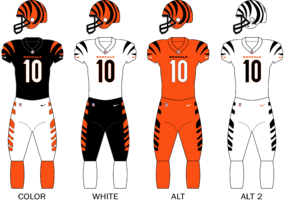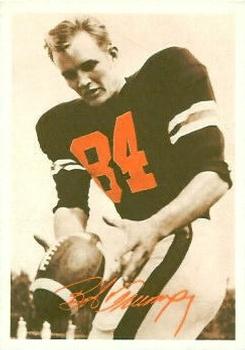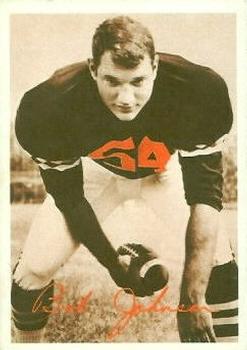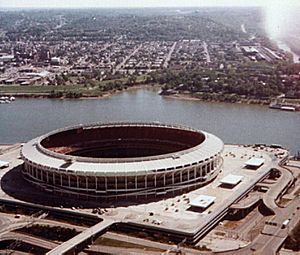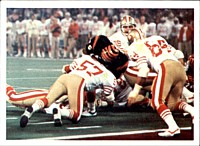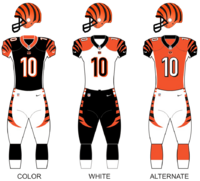Cincinnati Bengals facts for kids
Quick facts for kids Cincinnati Bengals |
|||||||||||||
|---|---|---|---|---|---|---|---|---|---|---|---|---|---|
|
|||||||||||||
| Basic info | |||||||||||||
| Established | May 23, 1967 | ||||||||||||
| Stadium | Paycor Stadium Cincinnati, Ohio |
||||||||||||
| Headquartered | Paycor Stadium Cincinnati, Ohio |
||||||||||||
| Colors | Black, Orange, White |
||||||||||||
| Fight song | The Bengals Growl | ||||||||||||
| Mascot | Bengal Tiger | ||||||||||||
| Personnel | |||||||||||||
| Owner(s) | Mike Brown | ||||||||||||
| President | Mike Brown | ||||||||||||
| General manager | Duke Tobin | ||||||||||||
| Head coach | Zac Taylor | ||||||||||||
| Team history | |||||||||||||
|
|||||||||||||
| Home fields | |||||||||||||
|
|||||||||||||
| League / conference affiliations | |||||||||||||
American Football League (1968–1969)
National Football League (1970–present)
|
|||||||||||||
| Championships | |||||||||||||
| League championships: 0 |
|||||||||||||
Conference championships: 3
|
|||||||||||||
Division championships: 11
|
|||||||||||||
| Playoff appearances (16) | |||||||||||||
|
|||||||||||||
| Owner(s) | |||||||||||||
|
|||||||||||||
The Cincinnati Bengals are a professional American football team. They are based in Cincinnati, Ohio. The Bengals play in the National Football League (NFL). They are part of the American Football Conference (AFC) North division. Their home games are played at Paycor Stadium in downtown Cincinnati.
The team was founded by former Cleveland Browns coach Paul Brown. He started planning for the Bengals in 1965. Cincinnati's city council approved building Riverfront Stadium in 1966. On May 23, 1967, the Bengals officially joined the American Football League (AFL). They began playing in the 1968 season. Paul Brown coached the team until 1975.
After being fired by the Browns in 1963, Brown wanted to create another NFL team in Ohio. He chose Cincinnati because a new stadium could be built there. This stadium would host both football and baseball games. The Bengals joined the AFL as its 10th and final team. This happened before the AFL and NFL merged in 1970. After the merger, the Bengals joined the AFC. Cincinnati was also a good choice because it could attract fans from nearby cities.
After Paul Brown passed away in 1991, his son, Mike Brown, took over the team. In 2011, Mike Brown became the main owner of the Bengals.
The Bengals won the AFC championship in 1981, 1988, and 2021. They lost to the San Francisco 49ers in Super Bowls XVI and XXIII. The team had a tough time in the 1990s and early 2000s. Fans sometimes called them "The Bungles." They went 14 years without reaching the NFL playoffs or having a winning season.
Things started to get better in the mid-2000s. The team became more consistent. In the 2021 season, they won their first playoff game in 31 years. They reached the AFC Championship game two years in a row. In 2021, they beat the Kansas City Chiefs 27–24 in overtime. This sent them to Super Bowl LVI, their first Super Bowl in 33 years. They lost to the Los Angeles Rams 23–20. In 2022, they made it to the AFC Championship game again. They lost to the Chiefs, who later won the Super Bowl.
The team does not have an official general manager. However, Duke Tobin handles most player decisions. He is like the team's general manager.
Contents
Team History
Starting the Team (1968–Present)
In 1967, a group led by Paul Brown started the Cincinnati Bengals team in the American Football League. Brown chose the name "Bengals" to connect with earlier football teams in Cincinnati. There was another Cincinnati Bengals team that played from 1937 to 1942. The city's famous zoo also had a rare white Bengal tiger.
Paul Brown picked the same shade of orange as his old team, the Cleveland Browns. He added black as a second color. The first logo was simply the word "BENGALS" in black letters. The Bengals started playing in the 1968 season.
In 1966, the AFL and the National Football League agreed to merge. The AFL was allowed to add one more team. This was to make sure there was an even number of teams in the merged league. The new team had to pay a large fee of $10 million. This money helped the AFL pay fees to the NFL as part of the merger.
Paul Brown did not originally want to join the AFL. He thought it was not as good as the NFL. But when the merger was announced, he realized joining the AFL was his best way back into the NFL. The Bengals were guaranteed to become an NFL team after the merger in 1970.
There was also a need for a new stadium. The Major League Baseball team, the Cincinnati Reds, needed a new home. Their old stadium, Crosley Field, was old and had parking problems. With help from Ohio's governor, Hamilton County and Cincinnati agreed to build a new multi-purpose stadium. It was called Riverfront Stadium. It was ready for the 1970 NFL season.
When the merger was complete in 1970, the Cleveland Browns moved to the AFC. They were placed in the same division as the Bengals. This created an instant rivalry. It was fueled by Paul Brown's history with the Browns.
Early Years and Playoff Struggles (1968–1978)
For their first two seasons, the Bengals played at Nippert Stadium. This is the home of the University of Cincinnati football team. In their first season, the team had a 3–11 record. Running back Paul Robinson rushed for 1,023 yards. He was named the AFL Rookie of the Year.
Paul Brown coached the team for its first eight seasons. He liked to draft players from smaller football schools. Many former players became successful in broadcasting or other fields.
In 1970, the Bengals moved to Riverfront Stadium. They shared it with the Cincinnati Reds until 2000. Notable players from the 1970s included Virgil Carter, Chip Meyers, and Bob Trumpy. The team made the playoffs three times in that decade. However, they could not win any playoff games. In 1975, the team had an 11–3 record. This is still the best winning percentage in team history. But they lost to the Oakland Raiders in the playoffs.
Super Bowl Appearances (1980–1991)
The Bengals reached the Super Bowl twice in the 1980s. They played in Super Bowl XVI and Super Bowl XXIII. Both times, they lost to the San Francisco 49ers. The team also made the playoffs in 1990. They reached the second round before losing.
In 1991, Paul Brown passed away at age 82. He had already given control to his son, Mike Brown. After this, the Bengals had a tough time. They had 14 straight seasons without a winning record. Many of their top draft picks did not become successful players.
Marvin Lewis Era (2003–2018)
The Bengals started to improve after Marvin Lewis became head coach in 2003. They drafted Carson Palmer, a future star quarterback, in 2003. In 2005, the team made the playoffs for the first time since 1990. They lost to the Pittsburgh Steelers. This was their first winning season since 1990.
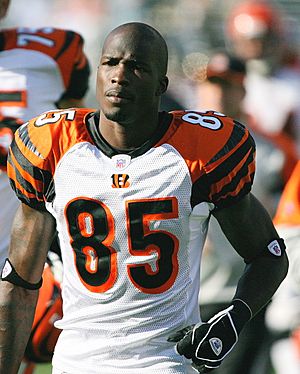
The Bengals returned to the playoffs in 2009. They won their division, sweeping all their division rivals. Marvin Lewis was named NFL Coach of the Year. In 2010, the team had a 4–12 record.
After the 2010 season, Carson Palmer asked to be traded. When the Bengals refused, he retired. He was later traded to the Oakland Raiders. In the 2011 NFL draft, the Bengals drafted wide receiver A. J. Green and quarterback Andy Dalton.
The Bengals improved to 9–7 in 2011 and made the playoffs. Dalton and Green became a great rookie duo. However, they lost to the Houston Texans in the Wild Card round. In 2012, they made the playoffs again. This was the first time since 1982 they went to the playoffs in back-to-back years. But they lost to the Texans again.
In 2013, the Bengals made the playoffs for the third straight year. They won the AFC North with an 11–5 record. But they lost again in the Wild Card round, this time to the San Diego Chargers. This meant the Bengals were 0–5 in playoff games under Mike Brown's ownership. In 2014, they made the playoffs for a fourth straight season. They lost to the Indianapolis Colts.
In 2015, the Bengals started with a great 8–0 record. But starting quarterback Andy Dalton got injured in Week 14. The Bengals finished with a 12–4 record, tying a team record. They lost to the Pittsburgh Steelers in the Wild Card round. This made them the first NFL team to lose five straight opening-round playoff games. In 2016, the Bengals finished 6–9–1 and missed the playoffs. This was the first time Andy Dalton missed the playoffs as the starting quarterback.
The 2017 season was also tough. The Bengals finished 7–9. Despite rumors, Marvin Lewis signed a new contract. In 2018, the Bengals started 4–1. But injuries to key players like A. J. Green and Andy Dalton hurt the team. They finished 6–10. On December 31, 2018, Marvin Lewis and the Bengals decided to part ways.
Zac Taylor Era (2019–Present)
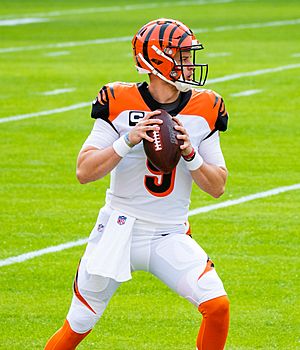
In 2019, Zac Taylor was hired as head coach. The team started with a close loss but then lost 10 more games. They were 0–11 heading into December. They got their first win against the Jets. They finished the season 2–14, tying their worst record in history. This earned them the No. 1 pick in the 2020 NFL draft.
In 2020, the Bengals improved with rookies Joe Burrow and Tee Higgins. They started 2–5–1. However, Joe Burrow suffered a season-ending knee injury in Week 11. The team finished 4–11–1.
In 2021, the Bengals won the AFC North with a 10–7 record. They swept their rivals, the Pittsburgh Steelers and Baltimore Ravens. Led by Joe Burrow and rookie receiver Ja'Marr Chase, they clinched the division. They beat the Kansas City Chiefs 34–31 to win the division. They then won their first playoff game since 1990, beating the Las Vegas Raiders. After that, they upset the top-seeded Tennessee Titans. A week later, they reached their first Super Bowl since 1989. They came back from being down 21–3 to beat the Chiefs 27–24 in overtime. They lost a close Super Bowl to the Los Angeles Rams 23–20.
In Week 1 of the 2022 NFL season, the Bengals lost to the Pittsburgh Steelers in overtime. After a 4–4 start, the Bengals won 8 straight games. They tied a team record for single-season wins. They earned a 3 seed in the AFC playoffs. They beat the Baltimore Ravens in the first round. Then, they won against the Buffalo Bills to reach a second straight AFC Championship. They faced the Kansas City Chiefs again but lost 23–20.
In the 2023 season, Joe Burrow suffered a wrist injury in Week 11. This ruled him out for the rest of the season. Backup quarterback Jake Browning played well. The Bengals finished 9–8 and missed the playoffs.
The 2024 season had high hopes with Burrow returning. However, Cincinnati started 4–8 due to a weak defense. They lost four games where they scored at least 33 points. This was an NFL record. The team finished strong, winning their last five games. They ended with a 9–8 record but missed the playoffs again. Burrow led the NFL in passing yards. Wide receiver Ja'Marr Chase won the triple crown. Defensive end Trey Hendrickson led the league in sacks.
In April 2025, Bengals executive Katie Blackburn talked about the team's lease on Paycor Stadium. She said the team could move if they didn't pick up the option after this year. She likes the stadium's downtown location and hopes to keep the team there. The Bengals had suggested a $120 million stadium renovation. Most of the money would come from taxpayers. This caused some disagreement with Hamilton County officials.
Team Look: Logos and Uniforms
When the Bengals started in 1968, their uniforms looked like the Cleveland Browns'. Paul Brown used equipment from his old team for the Bengals. The Browns' colors were brown, orange, and white. Their helmets were solid orange with a white stripe.
The Bengals' colors were orange, black, and white. Their helmets were a similar orange. They had the word "Bengals" in black letters on the sides. There was no stripe on the helmet. The Bengals were unique because they didn't have numbers on their sleeves until 1980. That year, they also changed their helmet face mask from gray to black.
In 1981, the team changed their uniforms. They kept black and white jerseys and white pants. But they added orange and black tiger stripes. They also introduced the orange helmets with black tiger stripes. These are still used today.
In 1997, the Bengals added a leaping tiger logo to their uniform sleeves. Another logo was a Bengal's head. But the striped orange helmet remained their main symbol. In 2004, new tiger stripe patterns were added. Black jerseys got orange tiger-striped sleeves. White jerseys got black tiger-striped sleeves. A new orange "B" logo with tiger stripes was introduced. The team also started wearing black pants. They also had an alternate orange jersey. The Bengals usually wear black uniforms at home. Since 2005, they wear white for September home games when it's hot.
In 2016, the Bengals showed off their all-white Color Rush uniform. It had black tiger stripes on the sleeves and pants.
On January 21, 2021, the club announced new uniform designs. They kept the striped helmet. But they simplified the look. They removed side and shoulder panels. They created a new sleeve stripe pattern. They also removed shadows from numbers and strokes from player names. The team's wordmark was put on the chest. The shade of orange was also changed. The Bengals now wear three different pants: black with orange stripes, white with black stripes, and white with orange stripes.
In 2022, the NFL allowed teams to use alternate helmets again. The Bengals showed off a white helmet with black stripes. They also brought back the all-white Color Rush uniform to go with the white helmets. In 2023, they paired the white helmet with their main white uniform.
In 2024, the Bengals added orange pants to their uniform options. They also showed a new all-orange uniform combination.
Team Mascots
The Bengals' official mascot is a Bengal tiger named Who Dey. His jersey number is 1. The team also has the Ben-Gals, their cheerleading squad. Laura Vikmanis was the oldest cheerleader in league history.
In 2012, the Cincinnati Zoo named a Malayan tiger "Who Dey." Over 1,000 Bengals season ticket holders voted for the name. This tiger was later moved to a zoo in Kansas.
Team Rivalries
Division Rivals
Cleveland Browns
The Bengals have a long-standing rivalry with the Cleveland Browns. It's often called the "Battle of Ohio." This rivalry started because former Browns coach Paul Brown created the Bengals. The teams' colors are similar. Paul Brown chose the same orange as the Browns for the Bengals. The Bengals' first uniforms were almost identical to the Browns'. The rivalry was strongest in the 1980s when both teams fought for playoff spots. The Bengals lead the series 55–48 as of the end of the 2024 season.
Pittsburgh Steelers
The Bengals and Pittsburgh Steelers play each other twice a year. They have been division rivals since 1970. This rivalry became more intense in the 2000s. They have met twice in the playoffs. Both games had hard hits and injuries. The Steelers lead the overall series 71–40. They also lead the postseason series 2–0. The Steelers have been more dominant since 2004. They have a 28–7 record against the Bengals since then.
Baltimore Ravens
The Bengals' rivalry with the Baltimore Ravens began when the original Browns team moved to Baltimore and became the Ravens. The rivalry grew when former Ravens defensive coordinator Marvin Lewis became the Bengals' head coach. The Ravens lead the all-time series 32–27 as of the 2024 season. The Bengals won their only playoff meeting in the 2022 AFC Wild Card round.
Contributions to NFL Football
No-Huddle Offense
A no-huddle offense is when a team quickly runs plays without huddling. This was usually done when time was running out in a game. However, Sam Wyche, the Bengals' head coach in 1988, made it a regular part of their game. By quickly setting up the next play, often in 5–10 seconds, the Bengals made it hard for the other team's defense to substitute players or rest. Because of this, the NFL made rules to give defenses enough time for substitutions when the offense changed players.
The Bengals first used the "no-huddle" in 1984. Many important games between the Bengals and the Buffalo Bills led to these NFL rule changes. Wyche also started using timeout periods to talk to his whole team on the sideline at once.
West Coast Offense
The West Coast offense is a passing strategy. It was created by former Bengals assistant Bill Walsh. Walsh developed this offense while he was an assistant coach for the Cincinnati Bengals from 1968 to 1975. Bengals quarterback Virgil Carter was the first to use Walsh's system successfully. He led the NFL in pass completion percentage in 1971. Ken Anderson took over as quarterback in 1972 and was even more successful. In 1975, Anderson's passing helped the Bengals win a famous game against the Buffalo Bills. This game showed how football was changing to a more passing-focused style. Anderson, drafted by Paul Brown in 1971, became an NFL MVP in 1981. He set a record for completion percentage in 1982.
Zone Blitz Defense
The defense designed to stop the West Coast offense also came from Cincinnati. Then-Bengals defensive coordinator Dick LeBeau created the zone blitz in the 1980s. He later coached the team from 2000 to 2002.
Season Records
Players
Current Roster
|
Cincinnati Bengals roster
|
|||||||||
|---|---|---|---|---|---|---|---|---|---|
Quarterbacks
Running backs
Wide receivers
Tight ends
|
Offensive linemen
Defensive linemen
|
Linebackers
Defensive backs
Special teams
|
Reserve lists
→ AFC rosters → NFC rosters |
||||||
Retired Numbers
| Cincinnati Bengals Retired Numbers | ||||
| No. | Player | Position | Seasons | Retired |
|---|---|---|---|---|
| 54 | Bob Johnson | C | 1968–79 | December 17, 1978 |
Some numbers are not officially retired but are rarely used:
- 13 has only been worn once since Ken Riley retired.
- 14 has not been worn since Andy Dalton left in 2019. Ken Anderson, one of the best Bengals quarterbacks, also wore 14.
- 78 has not been worn since Anthony Muñoz retired.
Pro Football Hall of Fame Members
Four players who spent time with the Bengals are in the Hall of Fame. Only Anthony Muñoz and Ken Riley played their entire careers with the Bengals. Bengals founder Paul Brown is also in the Hall of Fame, but he was inducted before starting the team.
| Cincinnati Bengals Hall of Famers | ||||
|---|---|---|---|---|
| Players | ||||
| No. | Name | Position | Season(s) | Inducted |
| 18 | Charlie Joiner | WR | 1972–1975 | 1996 |
| 78 | Anthony Muñoz | T | 1980–1992 | 1998 |
| 81 | Terrell Owens | WR | 2010 | 2018 |
| 13 | Ken Riley | CB | 1969–1983 | 2023 |
Bengals Player Awards
| NFL MVP Winners | ||
| Season | Player | Position |
|---|---|---|
| 1981 | Ken Anderson | QB |
| 1988 | Boomer Esiason | |
| AFL/NFL Rookie of the Year | ||
| Season | Player | Position |
|---|---|---|
| 1968 | Paul Robinson | RB |
| 1969 | Greg Cook | QB |
| 1985 | Eddie Brown | WR |
| 1992 | Carl Pickens | |
| 2021 | Ja'Marr Chase | |
| Comeback Player of the Year | |||
| Season | Player | Position | |
|---|---|---|---|
| 2003 | Jon Kitna | QB | |
| 2021 | Joe Burrow | ||
| 2024 | |||
| Maxwell Club NFL Coach of the Year | |
| Season | Coach |
|---|---|
| 1969 | Paul Brown |
| 1970 | |
| 2009 | Marvin Lewis |
| Walter Payton NFL Man of the Year | ||
| Season | Player | Position |
|---|---|---|
| 1975 | Ken Anderson | QB |
| 1986 | Reggie Williams | LB |
| 1991 | Anthony Muñoz | T |
40th Anniversary Team
In 2007, fans voted for an all-time team to celebrate the Bengals' 40th anniversary.
| Position | Player | Tenure |
|---|---|---|
| Offense | ||
| QB | Carson Palmer | 2003–2010 |
| RB | James Brooks | 1984–1991 |
| FB | Ickey Woods | 1988–1991 |
| WR | Chad Johnson | 2001–2010 |
| T. J. Houshmandzadeh | 2001–2008 | |
| TE | Dan Ross | 1979–1983, 1985 |
| OT | Anthony Muñoz | 1980–1992 |
| Willie Anderson | 1996–2007 | |
| G | Max Montoya | 1979–1989 |
| Dave Lapham | 1974–1983 | |
| C | Rich Braham | 1994–2006 |
| Defense | ||
| DE | Justin Smith | 2001–2007 |
| Ross Browner | 1978–1986 | |
| DT | Tim Krumrie | 1983–1994 |
| Mike Reid | 1970–1974 | |
| LB | Reggie Williams | 1976–1989 |
| Takeo Spikes | 1998–2002 | |
| Brian Simmons | 1998–2006 | |
| CB | Ken Riley | 1969–1983 |
| Lemar Parrish | 1970–1977 | |
| S | David Fulcher | 1986–1992 |
| Solomon Wilcots | 1987–1990 | |
| Special teams | ||
| K | Shayne Graham | 2003–2009 |
| P | Lee Johnson | 1988–1989 |
50th Anniversary Team
In 2017, a team was chosen for the Bengals' 50th anniversary. It was based on player statistics, team records, and votes.
| Position | Player | Tenure |
|---|---|---|
| Offense | ||
| QB | Boomer Esiason | 1984–1992, 1997 |
| Ken Anderson | 1971–1986 | |
| RB | Corey Dillon | 1997–2003 |
| FB | Pete Johnson | 1977–1983 |
| WR | Chad Johnson | 2001–2010 |
| Isaac Curtis | 1973–1984 | |
| Cris Collinsworth | 1981–1988 | |
| TE | Bob Trumpy | 1968–1977 |
| OT | Anthony Muñoz | 1980–1992 |
| Willie Anderson | 1996–2007 | |
| G | Max Montoya | 1979–1989 |
| Dave Lapham | 1974–1983 | |
| C | Bob Johnson | 1968–1979 |
| Defense | ||
| DE | Eddie Edwards | 1977–1988 |
| Coy Bacon | 1976–1977 | |
| DT | Tim Krumrie | 1983–1994 |
| Mike Reid | 1970–1974 | |
| LB | Reggie Williams | 1976–1989 |
| Bill Bergey | 1969–1973 | |
| Jim LeClair | 1972–1983 | |
| CB | Ken Riley | 1969–1983 |
| Lemar Parrish | 1970–1977 | |
| S | David Fulcher | 1986–1992 |
| Tommy Casanova | 1972–1977 | |
| Special teams | ||
| K | Jim Breech | 1980–1992 |
| P | Pat McInally | 1984–1991 |
| Coach | ||
| HC | Forrest Gregg | 1980–1983 |
| Sam Wyche | 1984–1991 | |
Ring of Honor
The Bengals started a Ring of Honor in 2021. The first members were Hall of Fame tackle Anthony Muñoz and founder Paul Brown. Ken Anderson and Ken Riley were added after a fan vote.
| Bengals Ring of Honor | ||||
| Inducted | No. | Player | Position | Tenure |
|---|---|---|---|---|
| 2021 | 78 | Anthony Muñoz | T | 1980–1992 |
| – | Paul Brown* | Founder Owner Coach |
N/A 1968–1991 1968–1975 |
|
| 14 | Ken Anderson | QB | 1971–1986 | |
| 13 | Ken Riley* | CB | 1969–1983 | |
| 2022 | 71 | Willie Anderson | T | 1996–2007 |
| 85 | Isaac Curtis | WR | 1973–1984 | |
| 2023 | 7 | Boomer Esiason | QB | 1984–1992, 1997 |
| 85 | Chad Johnson | WR | 2001–2010 | |
| 2024 | 28 | Corey Dillon | RB | 1997–2003 |
| 69 | Tim Krumrie | NT | 1983–1994 | |
*Posthumous induction
Coaching Staff
Head Coaches
Current Staff
|
→ Coaching staff |
|||||
Radio and Television
The Bengals partner with iHeartMedia for radio broadcasts. Their main radio stations are WCKY (1530) and WEBN (102.7 FM). WLW (700) also broadcasts games if it doesn't conflict with the Cincinnati Reds. Most preseason and regular season games are shown on WKRC-TV, channel 12, the CBS station. Mike Watts and Anthony Muñoz are the TV announcers for preseason games. Mike Valpredo is the sideline reporter. Games against NFC teams at Paycor Stadium are shown on WXIX, channel 19, the local Fox station. WLWT-TV airs games when the Bengals play on Sunday Night Football.
The radio team includes Dan Hoard (play-by-play) and Dave Lapham (analyst).
Team Culture
Fight Song
"The Bengal Growl" is the Bengals' fight song. It was written by George "Red" Bird when the team started in 1968. Bird was friends with Paul Brown. He had worked for the Browns before coming to Cincinnati. His first job was to write a fight song. The song is still very popular with Bengals fans. They sing it at "Bengals backer" bars everywhere. In 2021, Elizabeth Blackburn, a team executive, said the song is not going anywhere. "Welcome to the Jungle" is also a fight song for the Bengals. It is played before kickoffs to get fans excited.
Who Dey Chant
"Who Dey?!" is a famous chant by Cincinnati Bengals fans. It has been used since the 1980s. The full chant is: "Who dey, who dey, who dey think gonna beat dem Bengals?" The answer is, "Nobody." Sometimes fans just shout "Who Dey?" The team's mascot, a Bengal tiger, is also named Who Dey.
The chant might be connected to a local beer called Hudy. Beer vendors at the stadium would call out "If Hudy" when selling beer. Fans would chant back. This banter grew into the "Who Dey" chant.
The full "Who Dey" chant was first used by fans in 1980. One idea for its origin is a 1980 commercial for Red Frazier Ford. The commercial's slogan was: "Who's going to give you a better deal than Red Frazier?...Nobody!" Bengals fans might have copied this when cheering.
The chant is similar to "Who Dat?" used by the New Orleans Saints. "Who Dat?" was officially adopted by the Saints in 1983. But it had been used by high school teams in Louisiana for a while.
See also
 In Spanish: Cincinnati Bengals para niños
In Spanish: Cincinnati Bengals para niños
- List of Cincinnati Bengals seasons
- List of NFL team records
- Sports in Ohio
- Sports in Cincinnati



